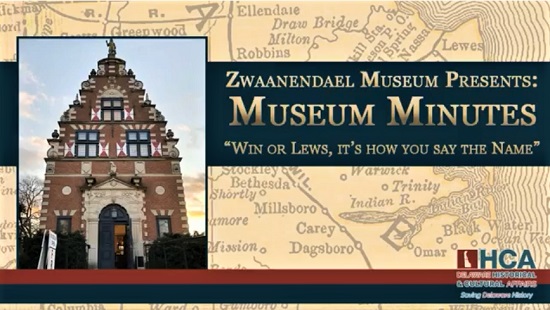‘Museum Minutes’: Sharing Delaware history digitally
By Kaitlyn Dykes, lead historic-site interpreter, Zwaanendael Museum
On March 31, 2020, the Zwaanendael Museum made one of its biggest announcements since the building closed one week earlier in response to the COVID-19 pandemic — “The Zwaanendael Museum is proud to introduce “Museum Minutes,” your daily dose of vitamin his-tor-E!”
With the doors closed and physical access to the museum impossible, staff realized that social media was a vehicle through which the museum could continue its commitment to sharing Delaware’s expansive history. Thus, “Museum Minutes” was created!
On the surface the idea was simple. Using our existing knowledge of local history and museum exhibits, we would create short videos which could be shared online, keeping people connected to the museum. Furthermore, each video could be coupled with a short activity designed to keep younger audiences engaged with the programming. Using this model, on April 1, 2020, the museum launched the “Museum Minutes” series of short history videos and accompanying activities which would be shared via social media every Wednesday and Saturday.
The first video was a hit! “Win or Lewes, It’s How You Say the Name” introduced viewers to the basics of Lewes’ history, focusing on how the town got its name, and putting the town and the museum into historical context. With more than 1,200 people reached on Facebook alone, it was clear that “Museum Minutes” was hitting its mark — People at home were still interested in connecting with Delaware history and were willing to try something new!
Throughout the month of April, we continued to produce a video twice a week, always focusing on a different part of Delaware- and Zwaanendael-Museum-history. Quickly, we learned that creating virtual programming takes a good deal of effort, requiring us to learn skills most of us had never needed to use before. Never had any of the museum staff done videography, audio-recording or video-editing. And although staff was experienced in historical research, a great deal more was necessary to maintain factual accuracy given the wide variety of “Museum Minutes” topics.
Ultimately the process looked a bit like this: Staff members would first brainstorm topics and then determine who would be responsible for researching the topic, finding images and writing the audio script. A staff member would then record the audio and film any necessary footage, after which all of the material would be put into video-editing software where it would be cut together, captioned for disabled access and sent for one final round of approval before it was posted for the general public. Many of these skills were ones that staff had to learn for themselves, pushing their knowledge base and expanding the scope of responsibilities that are required of history professionals today.
Once the museum reopened, time constraints reduced “Museum Minutes” production to one video per week and later, one video per month. Despite these constraints, staff were determined to continue creating digital content for those who were not able to visit the museum for one reason or another.
So far, “Museum Minutes” has been incredible and has taught us so much about how people connect with history. While videos will never be a replacement for visiting a site and interacting with history live and in-person, the series has proven that the future of museums may look very different. Perhaps just as importantly, “Museum Minutes” has allowed us to further explore Delaware’s diverse history. Since the first video launched, the series has covered everything from pirates to bay-and-river pilots, from African American religious festivals to salt production, from Native American trash middens to Fiji mermen and many things in between. Many of these topics are not usually covered in a Zwaanendael tour and the videos have provided opportunities to expand our historical interpretation beyond the physical boundaries of the museum.
So far, 21 videos have been created including 20 traditional episodes and one holiday special! The museum looks forward to continuing to create this content in order to expand accessibility to our history. After a brief hiatus, viewers can once again start tuning in with one episode each month as of October 2021. With museums moving further and further into the digital world we look forward to what’s next!
Kaitlyn Dykes has served as lead historic-site interpreter at the Zwaanendael Museum since July 2019. In addition to steering the “Museum Minutes” series, she assists in overseeing day-to-day operations, developing and implementing educational and interpretive programs, and coordinating community outreach and special events.





